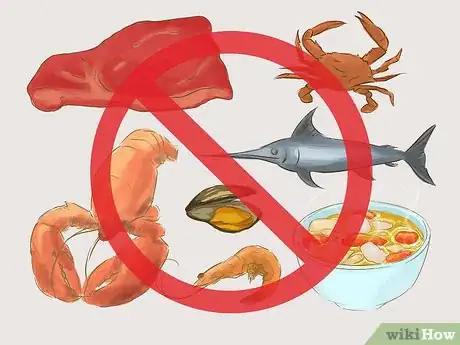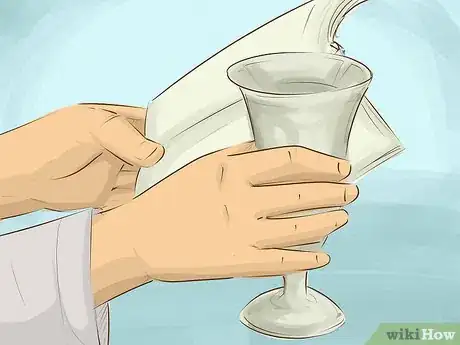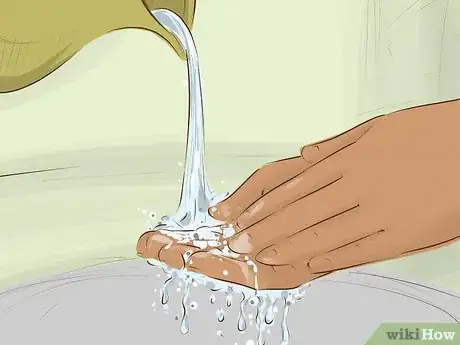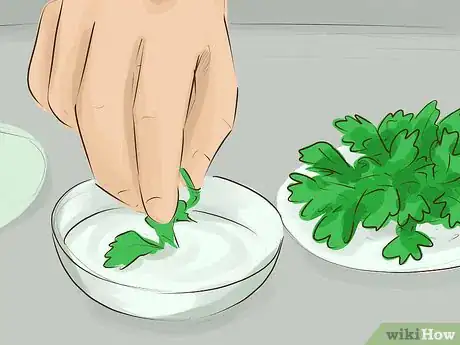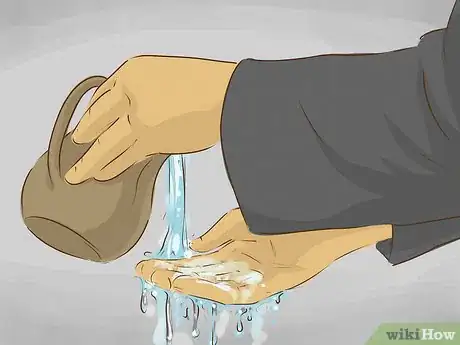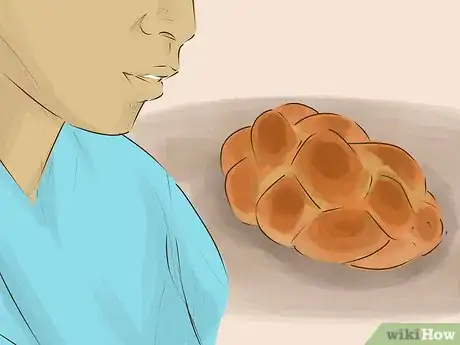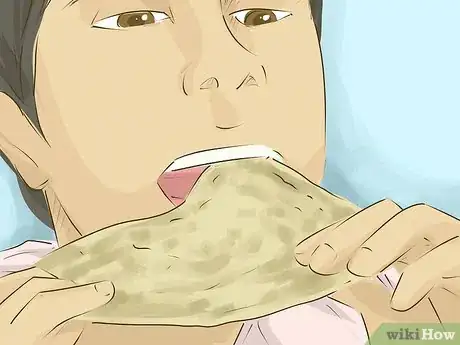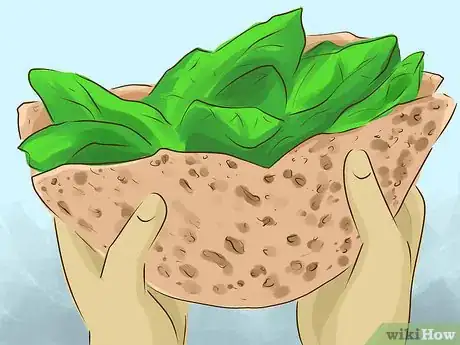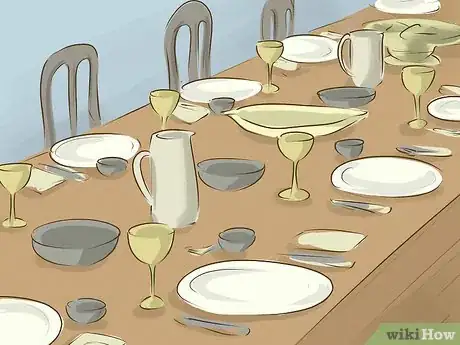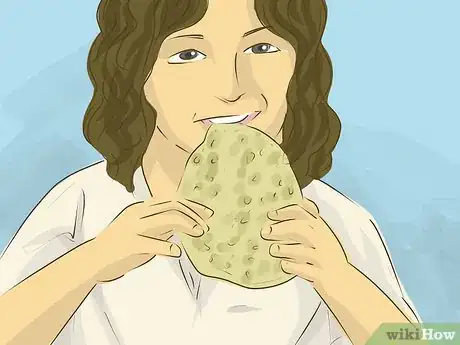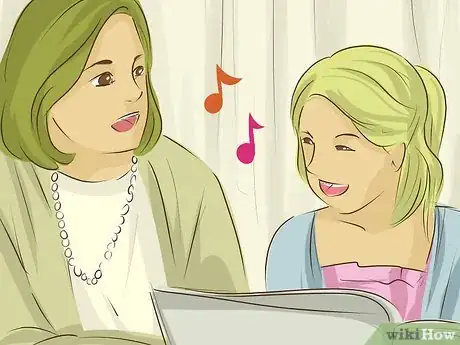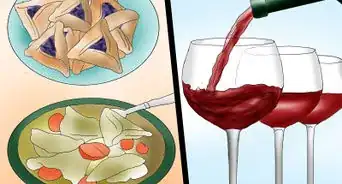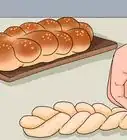This article was co-authored by wikiHow Staff. Our trained team of editors and researchers validate articles for accuracy and comprehensiveness. wikiHow's Content Management Team carefully monitors the work from our editorial staff to ensure that each article is backed by trusted research and meets our high quality standards.
There are 7 references cited in this article, which can be found at the bottom of the page.
wikiHow marks an article as reader-approved once it receives enough positive feedback. This article received 15 testimonials and 84% of readers who voted found it helpful, earning it our reader-approved status.
This article has been viewed 210,629 times.
Learn more...
Passover (called Pesach in Hebrew) is one of the most important holidays in Judaism. It commemorates the escape of the Jews from slavery in Egypt, and is celebrated annually either in March or April, depending on the dates in the Hebrew Calendar. The main themes highlighted in the seder ritual feast are freedom, redemption and thankfulness. If you want to celebrate Passover as someone new to Jewish customs, start by preparing properly for the Passover celebration and following the right customs when you attend the Passover meal. You can also celebrate Passover in other ways with movies or books if you cannot attend the traditional meal.
Steps
Preparing for the Passover Celebration
-
1Mark the date for Passover. Passover lasts for eight days. It begins at sundown in early spring, known as the month of Nissan in the Hebrew calendar. The start date of Passover will change every year based on when Nissan occurs in the Hebrew calendar. Consult a Hebrew calendar for the exact dates for Passover in your year.
- If you are going to a Passover celebration hosted by someone who is Jewish, ask them for the exact dates for Passover.
- Passover 2023 lasts from sundown of Wednesday 5th of April to the sundown of Thursday the 13th of April.[1]
-
2Take time off from work. Passover is divided into two parts. The first two days and the last two days of Passover are considered holidays, where no work is done. This includes driving, writing, or using electrical devices (among certain other activities categorized as labor). However, you can cook and carry items outdoors when needed under most circumstances; feel free to check with a reputable rabbinic authority for elaboration. The middle four days during Passover are called Chol Hamoed (literally, "weekday of the holiday") and nearly all forms of work are permitted during these days.[2]
- It can be an adjustment to not do work during the first two days and last two days of Passover. Do any work you need to get done before Passover begins or save it for the middle four days of Passover so you do not break with tradition.
Advertisement -
3Get rid of all leavened products. Any leavened products, known as chametz in Hebrew, should be removed before the beginning of Passover. This is to honor the unleavened bread that the Israelites ate when they left Egypt. It is part of the Passover tradition to avoid consuming or owning any food or drink that contains wheat products. Clean your home of any of these products to prepare for Passover.[3]
- This means any wheat, barley, rye, oats, or spelt products. You should also remove any bread, cake, cookies, cereal, pizza, pasta, and alcoholic beverages.
- This does not include products like baking powder or baking soda.
- Chametz is considered the 'anthesis' (the flowering period of a plant) of matzah and a representation of egotism. Getting rid of chametz is a key part of celebrating Passover and embracing selflessness.
-
4Clean your home. Another key aspect of Passover is cleaning the home before Passover begins. Do a thorough cleaning of every nook and cranny of your home, from room to room. Dust, mop, sweep, and wipe each surface in your home. Often the weeks leading to Passover are spent cleaning the home to prepare.[4]
-
5Avoid forbidden foods for Passover. As throughout the year, during Passover, you cannot eat certain non-kosher meats such as pork, shellfish, lobster, shrimp, crab, rabbit, and any seafood without fins or scales, such as swordfish and sturgeon. You cannot eat any products made with these ingredients.[5]
- It is also tradition to not eat meat in combination with dairy during Passover as during the year as well, in accordance with regular Jewish dietary laws. So, do not have cheese, butter, or cream sauce on beef or chicken.
- Fish and eggs are allowed during Passover as long as they are served with dairy or with meat.
- When you shop for Passover foods, look for the labels saying: "Kosher for Passover," "May be used for Passover," and "Kosher for Passover and all year round."
Attending the Passover Meal
-
1Put together a seder plate. The most important celebration of the Passover week is the seder, a festive meal, which is usually held on the first night of Passover. The seder plate plays a central role in the Passover celebration. It consists of six symbolic foods, plus three pieces of matzah which will be placed on a separate plate. The six symbolic foods are:[6]
- The Bitter Herbs. Traditionally this would be horseradish, but parsley, green onion, or celery can also be used.
- The Paste or Charoset. This is a sweet mixture which represents the mortar used by the slaves to build the pyramids of Egypt. It is usually a ground mixture of apples, nuts and wine. A variety of recipes can be found online.
- The Vegetable. This is a non-bitter, root vegetable such as a boiled potato. This represents the hard labor of the slaves.
- The Shankbone. This is a shankbone, usually lamb or goat, which symbolizes the sacrificial lamb of Passover.
- The Egg. A hard-boiled egg used to symbolize the offering made in the days of the Temple.
- The Lettuce. This is usually romaine, which like the bitter herbs symbolizes the bitterness of slavery.
-
2Get a copy of the Haggadah. This is a book which will contain the necessary prayers, as well as the procedures and story of Passover for the seder. It is a useful guide for how to perform the seder properly.
-
3Say the Kiddush. This is a blessing said over wine in honor of Passover. Say the Kiddush blessing and then drink the first of four cups of wine.[7]
- You can then pour the second cup of wine but do not drink it yet.
-
4Wash your hands (Urchatz). Wash your hands without a blessing. This is to prepare for the eating of the Karpas.[8]
-
5Eat the Karpas. This is a vegetable, usually parsley. Dip the vegetable in the saltwater and eat it.[9]
- The vegetable is a symbol of the humble origins of the Jewish people. The salt water is a symbol of the tears shed due to slavery.
-
6Break the matzah (unleavened bread). Break the middle of the three matzah on the table, known as "yachatz". Return the smaller part to the pile. The larger part will be returned to the pile for the afikoman.[10]
-
7Say the Maggid. Tell the story of Passover, which is the story of the Exodus of the Jews from Egypt. Have the youngest child ask the traditional four questions, and drink the second cup of wine. The traditional four questions are:[11]
- "What has changed, this night, from all the other nights? That in all other nights we eat both chametz and matzah, on this night, we eat only matzah?"
- "What has changed, this night, from all the other nights? That in all other nights we eat many vegetables, on this night, maror?"
- "What has changed, this night, from all the other nights? That in all other nights we do not dip vegetables even once, on this night, we dip twice?"
- "What has changed, this night, from all the other nights? On all other nights, we eat either sitting or reclining, either sitting or reclining. On this night, on this night, we all recline."
- At the end of the Maggid, a blessing is recited over the second cup of wine and then the cup is drunk.
-
8Wash your hands again (Rachtzah). This time, include a blessing. This is to prepare for the eating of the matzah.[12]
-
9Say the Motzi. Recite the traditional blessing for eating bread, called the ha-motzi, over the matzos.[13]
-
10Eat the Matzo. Recite the blessing for eating matzah and eat a small portion of the matzah.[14]
-
11Eat the Maror. Bless and eat the bitter herbs. These can be dipped in the Charoset.[15]
-
12Eat the Koreich. Make a sandwich of matzah, bitter herbs and charoset. Eat this.[16]
-
13Set the table (Shulchan Oreich). This is the big dinner. You can eat whatever you want (as long as it does not include leavening) but Jewish staples like gefilte fish, matzah ball soup, and brisket are traditionally most common.[17]
-
14Find and eat the afikoman (Tzafun). This is when the afikoman, the piece of matzah set aside earlier in the meal, is to be eaten as a dessert. Traditionally, children will steal it earlier in the meal and hide it for the adults to ransom back with candy or other small prizes.[18]
- Another option is to have the adults hide the afikoman. Then, the children can be paid in candy or toys to find and return it.
-
15Welcome Elijah (Bareich). Say the after-meal blessing and drink the third cup of wine. Then, pour the fourth cup of wine for the prophet Elijah and open the door of the home briefly to allow him entrance.[19]
-
16Say the Hallel. Recite psalms, bless the fourth cup of wine, and drink it.
-
17Conclude the evening (Nirtzah). Conclude the seder with wishes for the next year, songs, stories, or expressions of affection and faith.[20]
Celebrating Passover in Other Ways
-
1Watch Passover movies. You can watch movies relating to Passover with your family or children. Not only can this entertain the whole family, but it can serve to remind everyone of the importance of the holiday. It can also open up a discussion the history of the Jewish people and the purpose of Passover.
- One good option is the film The Prince of Egypt, which is appropriate and fun for children but also has music and acting excellent enough to entertain an adult.
- Another good movie to watch is The Ten Commandments starring Charlton Heston. This is a classic and will appeal to both the young and old.
- A good, more modern movie to watch, especially if your family prefers a little more drama, is The Devil's Arithmetic. In this film, a young Jewish girl (played by Kirsten Dunst) who is tired of celebrating Passover is magically transported back in time to a Nazi concentration camp. She learns the true meaning of struggle, the importance of remembering, and the value of family and heritage.
-
2Sing Passover songs. You can sing Passover songs, either modern or traditional, on your own or with your family or friends. Many can easily be found on YouTube but here are three good ones:
- A good traditional song for the whole family is Dayenu, which is upbeat and great for singing as a group.
- Shalom Sesame (A Jewish subset of Sesame Street) made an excellent Passover film that contains lots of great songs for young kids.
- For fun takes on modern songs, listen to The Ein Prat Fountainheads "Dayenu, Coming Home" or The Maccabeats "Les Misérables, A Passover Story".
-
3Make Passover crafts. There are a number of crafts you can make with children which will get them involved with and excited about the holiday, as well as allowing them to feel necessary and helpful.
- Make a matzo house. This can be done similarly to making a gingerbread house and makes a great centerpiece. Make it extra exciting for the kids by building the matzo house with chocolate and caramel. Just be sure any candy you use is kosher for Passover.
- Make a Passover seder plate. You can get your kids to make and decorate a plate and bowls for the seder plate. This can be a good Passover activity for children of any age group.
- Make an afikomen bag. You can also make a custom bag for the afikoman. Sew or buy a basic bag and let your kids decorate it with drawings, baubles, or any images related to Passover.
Community Q&A
-
QuestionCan I celebrate as a Christian?
 Community AnswerYes, of course!
Community AnswerYes, of course! -
QuestionO which day of Nissan does Passover begin?
 Community AnswerThe first night of Pesach (Passover), when the Seder happens, is on 14 Nissan. This will next occur on Friday 19, April 2019. The first day, when it is traditional to attend Shul is on 15 Nissan - Saturday 20 April 2019.
Community AnswerThe first night of Pesach (Passover), when the Seder happens, is on 14 Nissan. This will next occur on Friday 19, April 2019. The first day, when it is traditional to attend Shul is on 15 Nissan - Saturday 20 April 2019. -
QuestionI don't drink alcohol. Are there any alternatives to wine at the seder?
 Community AnswerYou could use grape juice or nonalcoholic 'wine'.
Community AnswerYou could use grape juice or nonalcoholic 'wine'.
References
- ↑ https://www.chabad.org/holidays/passover/pesach_cdo/aid/671901/jewish/When-Is-Passover-in-2023-2024-2025-2026-and-2027.htm
- ↑ https://www.chabad.org/holidays/passover/pesach_cdo/aid/671901/jewish/When-is-Passover-in-2013-2014-2015-2016-and-2017.htm
- ↑ https://www.chabad.org/holidays/passover/pesach_cdo/aid/871715/jewish/What-Is-Passover-Pesach.htm
- ↑ http://www.independent.co.uk/news/uk/home-news/passover-2016-everything-you-need-to-know-a6986651.html
- ↑ http://toriavey.com/what-foods-are-kosher-for-passover/#yuTKh0SLMWQX7Ruk.99
- ↑ http://www.chabad.org/holidays/passover/pesach_cdo/aid/1998/jewish/The-Seder-Plate.htm
- ↑ http://www.reformjudaism.org/passover-customs-and-rituals
- ↑ http://www.reformjudaism.org/passover-customs-and-rituals
- ↑ http://www.reformjudaism.org/passover-customs-and-rituals
- ↑ http://www.reformjudaism.org/passover-customs-and-rituals
- ↑ http://www.reformjudaism.org/passover-customs-and-rituals
- ↑ http://www.reformjudaism.org/passover-customs-and-rituals
- ↑ http://www.reformjudaism.org/passover-customs-and-rituals
- ↑ http://www.reformjudaism.org/passover-customs-and-rituals
- ↑ http://www.reformjudaism.org/passover-customs-and-rituals
- ↑ http://www.reformjudaism.org/passover-customs-and-rituals
- ↑ http://www.reformjudaism.org/passover-customs-and-rituals
- ↑ http://www.reformjudaism.org/passover-customs-and-rituals
- ↑ http://www.reformjudaism.org/passover-customs-and-rituals
- ↑ http://www.reformjudaism.org/passover-customs-and-rituals
About This Article
To celebrate Passover, first prepare the Seder plate, which contains the bitter herbs, the paste, the vegetable, the shankbone, the egg, and the lettuce, which make up the 6 symbolic foods. When you sit down to your Seder meal, read the various blessings and stories from the Haggadah, such as the Kiddush, Maggid, and Motzi. After each blessing, you should eat the symbolic food that goes with it to represent different elements of passover. When you’ve read all of the blessings and eaten the foods, finish the evening with wishes for the next year, songs, stories, and expressions of faith. Make sure you also avoid any leavened foods, such as bread, cake, pizza, and beer, for the duration of passover. For more tips, including how to make Passover crafts, read on!




